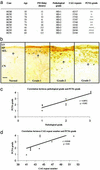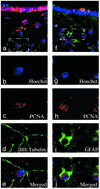Increased cell proliferation and neurogenesis in the adult human Huntington's disease brain
- PMID: 12853570
- PMCID: PMC166431
- DOI: 10.1073/pnas.1532244100
Increased cell proliferation and neurogenesis in the adult human Huntington's disease brain
Abstract
Neurogenesis has recently been observed in the adult human brain, suggesting the possibility of endogenous neural repair. However, the augmentation of neurogenesis in the adult human brain in response to neuronal cell loss has not been demonstrated. This study was undertaken to investigate whether neurogenesis occurs in the subependymal layer (SEL) adjacent to the caudate nucleus in the human brain in response to neurodegeneration of the caudate nucleus in Huntington's disease (HD). Postmortem control and HD human brain tissue were examined by using the cell cycle marker proliferating cell nuclear antigen (PCNA), the neuronal marker beta III-tubulin, and the glial cell marker glial fibrillary acidic protein (GFAP). We observed a significant increase in cell proliferation in the SEL in HD compared with control brains. Within the HD group, the degree of cell proliferation increased with pathological severity and increasing CAG repeats in the HD gene. Most importantly, PCNA+ cells were shown to coexpress beta III-tubulin or GFAP, demonstrating the generation of neurons and glial cells in the SEL of the diseased human brain. Our results provide evidence of increased progenitor cell proliferation and neurogenesis in the diseased adult human brain and further indicate the regenerative potential of the human brain.
Figures




Similar articles
-
The distribution of progenitor cells in the subependymal layer of the lateral ventricle in the normal and Huntington's disease human brain.Neuroscience. 2005;132(3):777-88. doi: 10.1016/j.neuroscience.2004.12.051. Neuroscience. 2005. PMID: 15837138
-
A novel population of progenitor cells expressing cannabinoid receptors in the subependymal layer of the adult normal and Huntington's disease human brain.J Chem Neuroanat. 2006 Apr;31(3):210-5. doi: 10.1016/j.jchemneu.2006.01.005. Epub 2006 Mar 14. J Chem Neuroanat. 2006. PMID: 16533591
-
Activating transcription factor 2 expression in the adult human brain: association with both neurodegeneration and neurogenesis.Neuroscience. 2005;133(2):437-51. doi: 10.1016/j.neuroscience.2005.02.029. Neuroscience. 2005. PMID: 15878807
-
Neurogenesis in Huntington's disease: can studying adult neurogenesis lead to the development of new therapeutic strategies?Brain Res. 2011 Aug 11;1406:84-105. doi: 10.1016/j.brainres.2011.06.040. Epub 2011 Jun 23. Brain Res. 2011. PMID: 21742312 Review.
-
Intervention of Proliferation and Differentiation of Endogenous Neural Stem Cells in the Neurodegenerative Process of Huntington's Disease Phenotype.CNS Neurol Disord Drug Targets. 2011 Jun;10(4):486-99. doi: 10.2174/187152711795563967. CNS Neurol Disord Drug Targets. 2011. PMID: 21495959 Review.
Cited by
-
Sox21 promotes hippocampal adult neurogenesis via the transcriptional repression of the Hes5 gene.J Neurosci. 2012 Sep 5;32(36):12543-57. doi: 10.1523/JNEUROSCI.5803-11.2012. J Neurosci. 2012. PMID: 22956844 Free PMC article.
-
Human multipotent stromal cells (MSCs) increase neurogenesis and decrease atrophy of the striatum in a transgenic mouse model for Huntington's disease.PLoS One. 2010 Feb 22;5(2):e9347. doi: 10.1371/journal.pone.0009347. PLoS One. 2010. PMID: 20179764 Free PMC article.
-
Potential of adult neural stem cells for cellular therapy.Biologics. 2007 Mar;1(1):53-8. Biologics. 2007. PMID: 19707348 Free PMC article.
-
Twist1 Plays an Anti-apoptotic Role in Mutant Huntingtin Expression Striatal Progenitor Cells.Mol Neurobiol. 2020 Mar;57(3):1688-1703. doi: 10.1007/s12035-019-01836-x. Epub 2019 Dec 7. Mol Neurobiol. 2020. PMID: 31813126
-
Supt16 Haploinsufficiency Impairs PI3K/AKT/mTOR/Autophagy Pathway in Human Pluripotent Stem Cells Derived Neural Stem Cells.Int J Mol Sci. 2023 Feb 3;24(3):3035. doi: 10.3390/ijms24033035. Int J Mol Sci. 2023. PMID: 36769360 Free PMC article.
References
-
- Svendsen, C. N., Caldwell, M. A., Shen, J., ter Borg, M. G., Rosser, A. E., Tyers, P., Karmiol, S. & Dunnett, S. B. (1997) Exp. Neurol. 148, 135-146. - PubMed
-
- Freed, C. R., Greene, P. E., Breeze, R. E., Tsai, W. Y., DuMouchel, W., Kao, R., Dillon, S., Winfield, H., Culver, S., Trojanowski, J. Q., et al. (2001) N. Engl. J. Med. 344, 710-719. - PubMed
-
- Morshead, C. M., Reynolds, B. A., Craig, C. G., McBurney, M. W., Staines, W. A., Morassutti, D., Weiss, S. & van der Kooy, D. (1994) Neuron 13, 1071-1082. - PubMed
-
- Arvidsson, A., Collin, T., Kirik, D., Kokaia, Z. & Lindvall, O. (2002) Nat. Med. 8, 963-970. - PubMed
Publication types
MeSH terms
Substances
LinkOut - more resources
Full Text Sources
Other Literature Sources
Medical
Miscellaneous

